In the ever-evolving world of skincare, few regimens offer both simplicity and effectiveness quite like the 3 step face care routine. As modern consumers grow more mindful of what they apply to their skin, holistic approaches are steadily gaining ground—emphasizing not only external appearance but also internal balance, emotional wellness, and long-term skin health. The essential 3 step face care ritual, rooted in both science and nature, aligns seamlessly with these values, offering a streamlined yet powerful approach to achieving radiant, resilient skin.
Unlike complex routines that require a shelf full of products and an hour of time each night, the 3 step face care method embraces the concept of doing more with less. By focusing on cleansing, nourishing, and protecting the skin in a mindful, consistent way, this minimalist strategy delivers profound results without unnecessary complication. Within holistic body care, this ritual is not just about surface-level aesthetics; it is a meditative practice, a daily moment of self-connection, and a commitment to harmonizing body, mind, and skin health. As we explore this transformative process, it becomes evident that true skincare goes far beyond product—it’s about intention, rhythm, and aligning with the skin’s natural intelligence.
You may also like: The Essential Rituals for a Natural Skincare Routine That Supports Whole-Body Wellness
Embracing Simplicity in a Complex Skincare Landscape
Today’s skincare market is saturated with promises—anti-aging miracles, instant glow, poreless perfection. The pressure to adhere to elaborate 10-step regimens, layer dozens of serums, or constantly chase the next trending ingredient has led many to experience skin fatigue, irritation, and even long-term barrier damage. In contrast, the 3 step face care ritual offers a grounded alternative: simple, elegant, and backed by both dermatological principles and traditional self-care wisdom.
Holistic skincare is not merely about avoiding synthetic ingredients; it’s about addressing the whole person. It acknowledges that skin health reflects internal states—nutrition, hydration, hormonal balance, stress levels, and environmental exposure. A consistent 3 step skin care routine allows for greater focus and consistency, promoting healthier habits while honoring the skin’s rhythm. It creates space to listen to the body’s needs rather than drowning them in excess.
By stripping away the noise and focusing on the essentials, individuals are empowered to make informed, intentional choices. Rather than reacting to marketing claims or fleeting trends, they can tune into what truly benefits their unique skin type. In this way, the three step skin care approach supports not only physical rejuvenation but also emotional clarity and mental ease.
The Science of Skin Renewal and Ritual
Before diving into each component of the ritual, it’s important to understand how skin renewal functions on a biological level. The skin is a dynamic organ, undergoing continuous regeneration. On average, it takes about 28 to 40 days for the outermost layer of the skin, the stratum corneum, to fully renew. This cycle can be disrupted by poor lifestyle habits, inadequate hydration, sun damage, stress, and aggressive skincare routines.
A holistic skin care strategy supports this regenerative cycle by reducing inflammation, preserving the skin barrier, and providing targeted nourishment. The three step skincare routine creates a supportive framework for this process. Each step—cleansing, treatment, and moisturizing—plays a distinct role in facilitating optimal cellular turnover, collagen synthesis, and protection from environmental stressors.
Incorporating this daily ritual also signals the nervous system to slow down, releasing the stress that often contributes to flare-ups and dullness. Rituals are calming by nature. When we approach our skincare routine as a sacred moment, not a hurried obligation, we activate the parasympathetic response—lowering cortisol, boosting circulation, and allowing deeper absorption of nutrients.
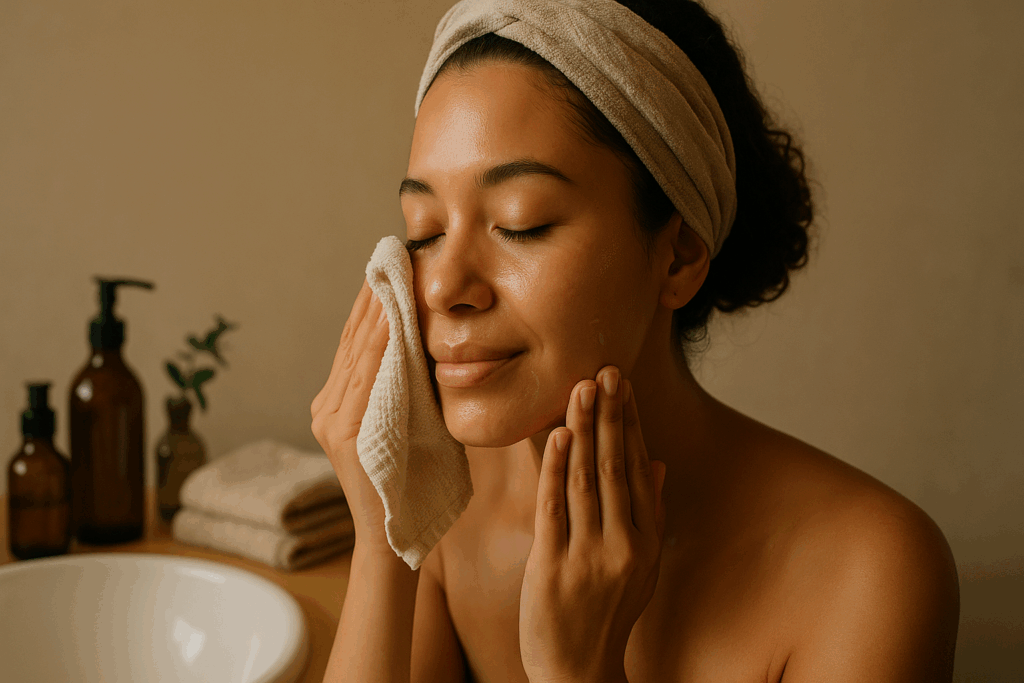
Step One: The Art and Science of Cleansing
The first step in the 3 step skin care process is cleansing—a deceptively simple action that holds far more significance than many realize. Cleansing prepares the skin for everything that follows, removing impurities, excess oils, pollutants, and traces of makeup that can clog pores or trigger inflammation. However, not all cleansers are created equal, and the holistic perspective insists on going beyond harsh foaming agents or alcohol-based formulas.
Traditional skincare often relied on soap-based cleansers with high pH levels that stripped the skin of its natural oils. Today, modern dermatological understanding recommends gentle, pH-balanced options that support the skin’s microbiome. The skin is home to a complex community of beneficial bacteria that defend against pathogens and help regulate immune responses. Over-cleansing or using aggressive products can disrupt this microbiome, leading to breakouts, dryness, and long-term sensitivity.
Holistic cleansing involves not only product selection but technique and intention. Lukewarm water, upward circular motions, and a brief pause to breathe deeply during this process all contribute to a more mindful experience. Oil cleansers—often made with jojoba, sunflower, or sweet almond oils—are particularly well-suited for this step. These natural oils dissolve sebum and impurities without compromising the lipid barrier. Double cleansing, a method that involves starting with an oil-based cleanser followed by a gentle water-based one, is especially effective for removing sunscreen and makeup residues without irritation.
Additionally, ingredients such as chamomile, green tea, calendula, and aloe vera offer anti-inflammatory benefits while soothing the skin. Choosing formulations free from synthetic fragrances, parabens, and sulfates ensures that this foundational step supports holistic renewal rather than undermining it. Ultimately, a mindful cleanse is not only about what is removed from the skin, but what is preserved—its integrity, its moisture, and its natural resilience.
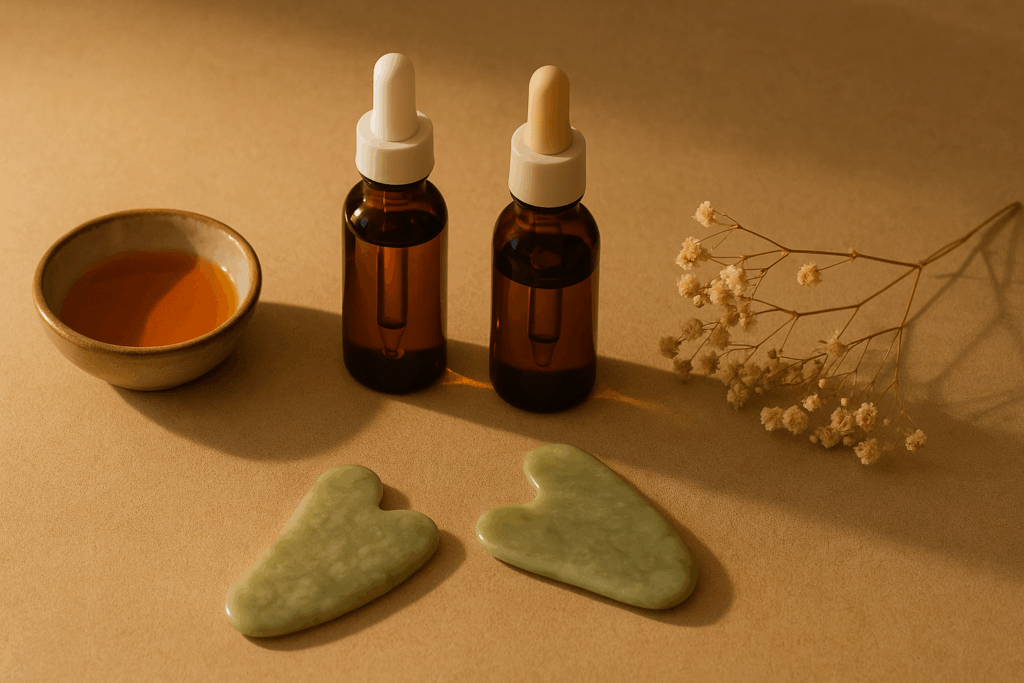
Step Two: Nourishing with Intention
The second phase of the 3 step skincare routine centers on nourishment. Often referred to as the “treatment” step, this is where active ingredients and targeted serums come into play. From a holistic standpoint, nourishment means more than delivering actives—it involves supporting the skin’s natural intelligence, repairing damage, and fortifying its defenses against daily stressors.
Serums and elixirs, which often contain a high concentration of ingredients, are ideal for this step. Depending on skin type and needs, one might choose hyaluronic acid for hydration, vitamin C for brightening and antioxidant protection, niacinamide for barrier support, or peptides for collagen stimulation. But in holistic care, we also turn to ancient botanicals that have stood the test of time. Rosehip oil, known for its regenerative properties; sea buckthorn, rich in omega-7 and antioxidants; and centella asiatica, renowned for soothing inflammation, all offer potent support without the risks of overexposure to synthetic compounds.
One of the key insights here is that more is not always better. Overloading the skin with too many active ingredients can lead to irritation and imbalance. Instead, we look for synergy—formulas where ingredients work in harmony with each other and with the skin. Holistic skincare emphasizes the concept of “intelligent simplicity,” where the few selected ingredients do the most good without overwhelming the skin’s ability to process and respond.
This phase of the ritual is also an ideal moment for lymphatic massage or gentle facial acupressure. These techniques improve circulation, reduce puffiness, and enhance product absorption. Even a few minutes of light massage using fingertips or a gua sha tool can create a visible shift in skin tone and texture. In essence, nourishing the skin becomes a meditative act—offering the body support while engaging the mind in present-moment awareness.
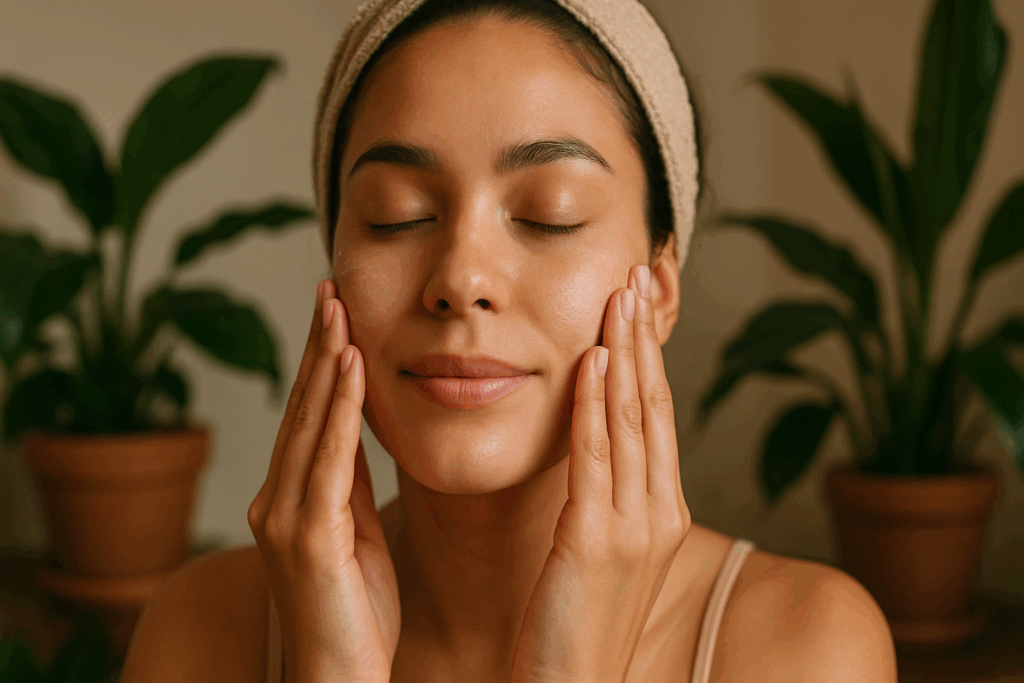
The Final Phase: Moisturizing and Protecting the Skin Barrier
No 3 step face care ritual is complete without the critical third phase: moisturizing. This step serves not only to seal in the nourishment provided in the previous stage, but to actively reinforce the skin’s moisture barrier—a crucial function often underestimated in conventional skincare discussions. The moisture barrier, composed of lipids, proteins, and natural moisturizing factors, protects the skin from water loss, bacteria, and pollutants. When this barrier is compromised, the result is often dryness, redness, flaking, and increased sensitivity.
Holistic moisturizers focus on replenishing this barrier using ingredients that mimic the skin’s own natural oils. Emollients like shea butter and squalane, humectants such as glycerin and aloe, and occlusives like beeswax or plant-based butters create a comprehensive shield that retains hydration while allowing the skin to breathe. Choosing a moisturizer with adaptogenic herbs, such as ashwagandha or holy basil, can also help the skin better respond to environmental stressors by modulating cortisol responses and improving cellular resilience.
Additionally, many people benefit from adjusting their moisturizer according to climate and season. Lighter gel-based formulas may suffice in humid environments or during summer, while richer creams are often more appropriate for dry winter air. From a holistic standpoint, even the time of day can influence our skincare needs. Daytime moisturizers often include ingredients like green tea or licorice root for antioxidant protection, while evening products may incorporate calming oils such as lavender or blue tansy to support nighttime repair processes.
Crucially, this final step is not just about sealing in moisture, but about offering protection. Including SPF during the daytime is non-negotiable in a well-rounded skincare strategy. Broad-spectrum mineral sunscreens with zinc oxide or titanium dioxide provide effective UV protection without the hormone-disrupting chemicals found in some conventional formulas. Holistic skin care recognizes sun protection as a foundational step in preventing premature aging, hyperpigmentation, and cellular damage.
Why the 3 Step Face Care Ritual Works Across Skin Types
One of the most compelling aspects of the 3 step face care method is its universality. Unlike regimens that require different approaches for oily, dry, combination, or sensitive skin types, this ritual offers foundational care that can be customized for each individual without overcomplication. At its core, the process respects the skin’s own regenerative capabilities while offering targeted support, making it adaptable to virtually anyone’s skincare journey.
Oily and acne-prone individuals often shy away from moisturizing, assuming it will exacerbate breakouts. However, consistent use of non-comedogenic, lightweight moisturizers and oil-balancing cleansers can actually regulate sebum production over time. For these skin types, incorporating ingredients like niacinamide, green tea extract, and salicylic acid within a three step skin care routine provides effective control without dryness or irritation.
Those with dry or sensitive skin benefit immensely from the protective structure of this approach. Using barrier-repairing serums and rich, hydrating moisturizers soothes inflammation and reduces flakiness. Calming botanicals such as oat extract, calendula, and marshmallow root further enhance the results, especially when combined with gentle cleansing methods that do not strip natural oils. For individuals with rosacea or eczema-prone skin, a minimalist approach often brings better results than layering multiple actives that may inadvertently trigger flare-ups.
Even those with combination skin—which presents both dry and oily zones—can customize their 3 step skincare routine by selecting products with balanced formulations. Rather than alternating between multiple steps for different areas of the face, they can rely on multifunctional products that meet various needs simultaneously. In this way, the ritual becomes not just adaptable, but intuitive—a form of self-knowledge and attentiveness that deepens over time.
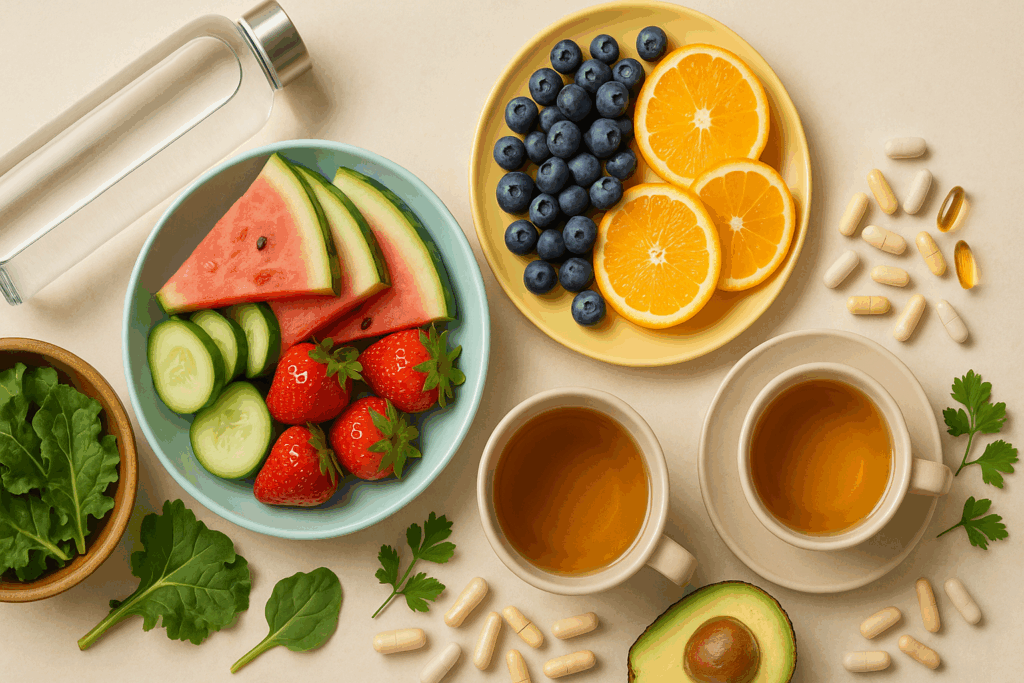
The Role of Internal Health in External Radiance
True holistic skincare does not isolate the skin from the rest of the body. Instead, it recognizes the skin as a mirror of internal health. Digestive function, hormonal balance, sleep quality, hydration levels, and emotional wellbeing all influence how the skin behaves. As such, any 3 step skin care routine becomes more effective when supported by a lifestyle that nourishes the body from within.
For example, dehydration often manifests as dullness, tightness, and increased fine lines. No external moisturizer can fully compensate for a lack of internal hydration. Drinking adequate water, consuming electrolytes, and eating water-rich foods like cucumber, berries, and leafy greens all help to plump the skin and enhance its receptivity to topical treatments.
Hormonal imbalances, particularly involving estrogen, cortisol, or androgens, are frequently linked to adult acne, melasma, or sudden sensitivity. Addressing these through medical consultation, stress management, adaptogens, or supportive nutrition—such as flaxseed for estrogen balance or magnesium for cortisol modulation—can bring about visible changes in the skin. A balanced gut microbiome also plays a critical role; research shows that gut dysbiosis is often associated with inflammatory skin conditions like acne and eczema. Fermented foods, prebiotic fibers, and probiotics may all support a clearer, more even complexion when used alongside the right topical skincare strategy.
Sleep, often undervalued, is another key factor. During deep sleep, the body releases growth hormone and begins its most intensive repair processes. Collagen production increases, inflammation decreases, and the skin’s barrier regenerates more effectively. Integrating the three step skincare routine into a soothing nighttime ritual—complete with herbal teas, essential oils, and screen-free time—can improve sleep quality and, by extension, skin clarity and tone.
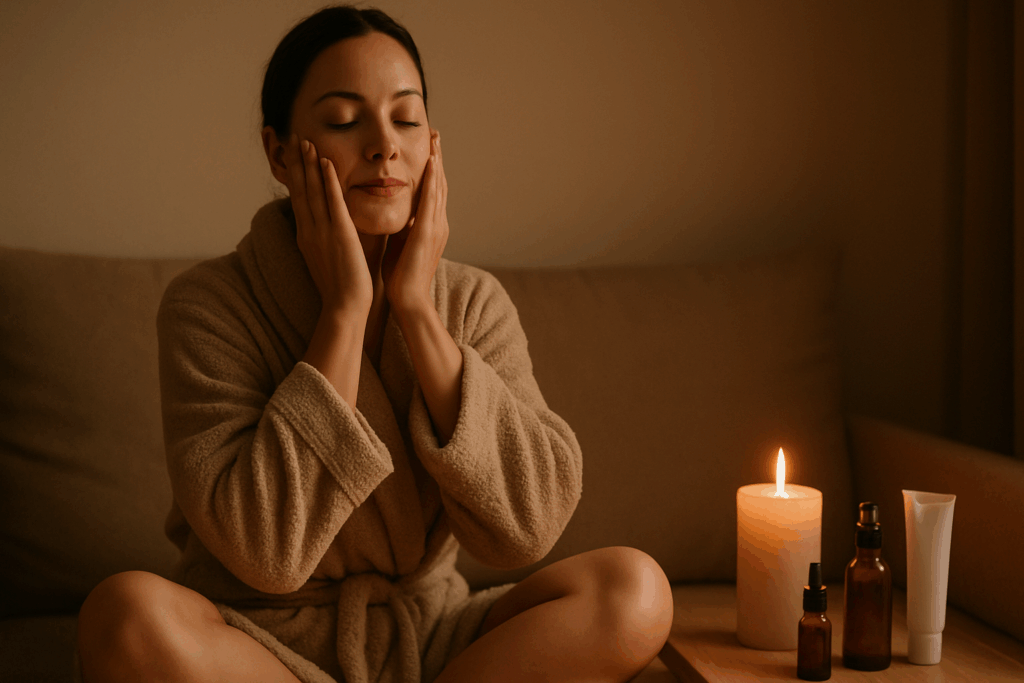
Ritual as Emotional Medicine: Skincare as Self-Care
Beyond the physiological effects, the emotional and psychological dimensions of a skincare ritual hold deep significance. In a world that often feels chaotic and overstimulating, the act of caring for one’s face each morning and evening can become a grounding anchor. This isn’t vanity—it’s reverence. It’s the daily decision to slow down, reconnect with oneself, and honor the physical body with gentleness and care.
The predictability of a three step skin care process offers structure in uncertain times. It becomes a form of self-parenting—a small but powerful reminder that you are worthy of care, attention, and nurturing. Many individuals report that sticking to such a ritual improves their mental health, giving them a moment of mindfulness that ripples into the rest of their day.
Neuroscience supports this. Acts of self-touch, especially on the face, activate the prefrontal cortex and downregulate the amygdala, which processes fear and stress. The warm water of cleansing, the tactile nature of applying serum, the comforting richness of moisturizer—all stimulate the vagus nerve and promote parasympathetic dominance. This fosters a sense of safety, calm, and balance that is particularly beneficial for individuals with anxiety or chronic stress.
Moreover, these rituals provide a space for reflection and intention-setting. With practice, one might choose to pair the 3 step face care ritual with affirmations, breathwork, or gratitude exercises. As the skin improves, so does the sense of self—creating a positive feedback loop that reinforces commitment to both internal and external wellness.
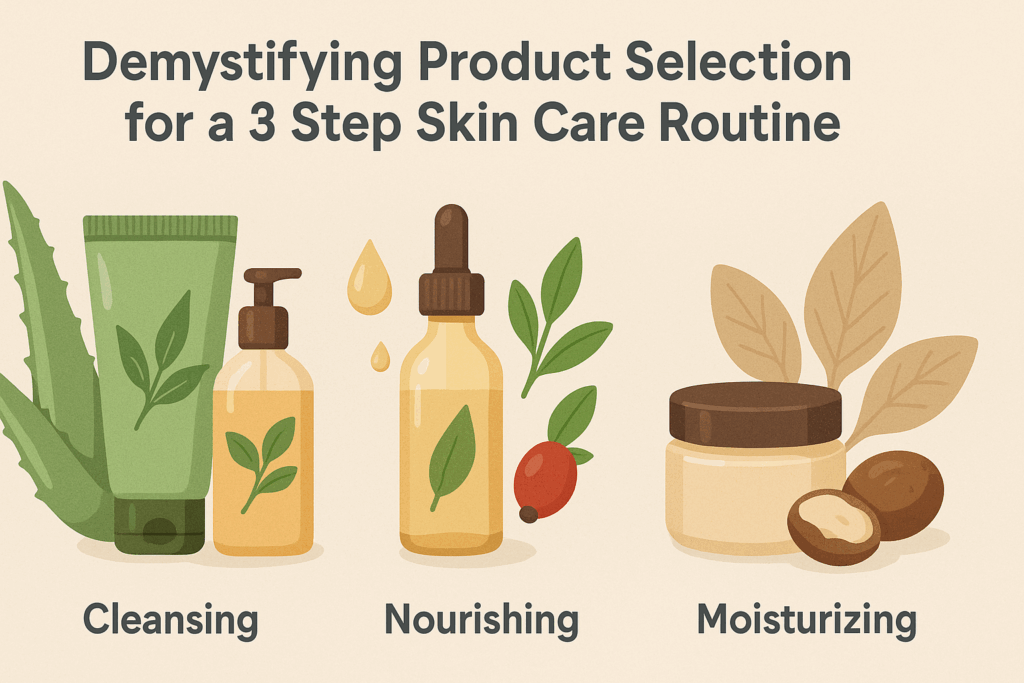
Demystifying Product Selection for a 3 Step Skin Care Routine
Choosing the right products for a 3 step face care ritual can feel overwhelming at first, given the vast number of options on the market. However, applying a few guiding principles rooted in both holistic wisdom and dermatological research can significantly simplify the process.
For cleansers, the emphasis should be on preserving the skin’s acid mantle. Look for gentle, non-stripping formulas with pH values between 4.5 and 5.5. Avoid harsh surfactants like sodium lauryl sulfate, which can erode the skin’s barrier, and instead opt for ingredients like coco-glucoside, oat amino acids, or micellar technology. Cleansers containing adaptogenic herbs or calming agents like aloe, licorice root, or green tea provide added benefits for sensitive or reactive skin types.
The treatment step—the heart of the 3 step skin care routine—is where individual needs come most sharply into focus. Instead of choosing based on marketing claims, examine the ingredient list, concentration, and delivery system. For example, vitamin C is best delivered in stable forms such as sodium ascorbyl phosphate or magnesium ascorbyl phosphate, especially when paired with ferulic acid for maximum efficacy. If dealing with hyperpigmentation, ingredients like alpha arbutin, tranexamic acid, and bearberry extract can be effective without the risks associated with hydroquinone.
Moisturizers should be chosen not only based on skin type, but also based on climate, time of day, and specific concerns. Holistic moisturizers often contain plant-based emollients, bioavailable vitamins, and gentle antioxidants. Avoid artificial fragrances, dyes, and drying alcohols. Instead, look for formulations that include plant ceramides, cold-pressed oils, and ingredients that strengthen the skin barrier. Some holistic brands now offer “ritual creams” that double as aromatherapeutic treatments, incorporating essential oils like frankincense or rose to enhance emotional wellbeing during application.
When used together, these products don’t need to be expensive or complicated. In fact, a thoughtfully curated, affordable regimen often outperforms luxury products when consistency and intention are prioritized. This is where the 3 step skincare routine excels—it is sustainable, scalable, and effective across time and life stages.
Redefining Beauty: From Perfection to Vitality
At the heart of the holistic skincare movement lies a fundamental redefinition of beauty. Rather than chasing flawlessness, which is both unattainable and rooted in commercial insecurity, the focus shifts toward vitality, presence, and radiance. The 3 step face care ritual becomes a vehicle for this transformation—not only of the skin, but of perception itself.
Holistic beauty honors uniqueness. It embraces laugh lines as evidence of joy, freckles as expressions of ancestry, and texture as the natural poetry of skin. Instead of masking perceived imperfections, the three step skin care process enhances the skin’s inherent qualities. It supports skin that reflects how you feel—healthy, alive, and resilient—rather than striving for filtered perfection.
This mindset is especially important in a digital era dominated by altered images, unrealistic standards, and constant comparison. Adopting a nourishing, intentional skincare practice becomes an act of resistance—an affirmation that your worth is not contingent on meeting artificial ideals. True beauty, in this context, is not something you “achieve”; it is something you embody when you align with your body’s needs and rhythms.
As such, the 3 step skincare routine is not just a beauty strategy—it is a philosophy. It invites you to treat your skin not as a problem to be solved, but as a partner in your journey toward wholeness. It encourages presence, patience, and compassion, which ripple outward to affect not just your appearance but your confidence, energy, and sense of self.
Building Consistency and Ritual in Everyday Life
One of the most profound benefits of the 3 step face care ritual is that it fosters consistency. In an age defined by distraction and information overload, the ability to establish steady, supportive habits is a rare and precious skill. A skincare ritual may seem small, but its cumulative impact can be significant—both for the skin and the psyche. When this routine is embraced with presence and regularity, it creates a stabilizing force that grounds daily life in intentionality and care.
Consistency in skincare yields results that no single product or treatment can replicate. Over time, the skin adapts to a reliable routine, allowing its natural defenses and regenerative processes to flourish. Inflammation diminishes, texture evens out, and radiance returns. These benefits are not the result of magic or marketing hype; they are the predictable outcomes of respecting the skin’s biology and supporting it consistently.
Furthermore, establishing a consistent ritual allows for better insight into what truly works for your skin. When product use is erratic or layered with conflicting ingredients, it becomes difficult to track cause and effect. However, with a minimalist, three step skin care approach, individuals can make mindful adjustments based on how their skin responds—adding a new serum in winter, swapping a cleanser during hormonal shifts, or increasing hydration during travel. This process of observation and adaptation enhances body literacy and builds a sense of agency in one’s wellness journey.
In practical terms, this means setting aside time—perhaps five minutes in the morning and ten at night—not just for skincare, but for self-connection. Light a candle, play calming music, or simply breathe deeply as you massage your moisturizer into your skin. These moments, however brief, have the power to transform the mundane into the meaningful.
How to Find the Right Skincare Routine for You
Understanding how to find the right skincare routine often begins with self-education and a willingness to listen to your body. While general guidelines can be helpful, every individual’s skin is unique—shaped by genetics, environment, lifestyle, age, and even emotions. This is why the 3 step face care method is so powerful: it creates a flexible structure that adapts to these variables without overwhelming the user.
Start by identifying your skin type, but don’t become overly fixated on labels. Skin is dynamic—it can be dry in winter, oily in summer, or reactive during times of stress. The key is to observe patterns over time. Track how your skin responds to products, weather changes, and diet. Use a journal if needed, and consider photographing your skin weekly to monitor progress objectively.
Seek products with transparent ingredient lists and avoid formulations that rely heavily on alcohols, synthetic fragrance, or known irritants. Holistic skincare often incorporates plant-based ingredients, but even natural compounds can cause reactions—so patch testing is essential. If you are drawn to a particular brand or product, research their sourcing, sustainability, and formulation philosophies to ensure alignment with your values.
Consulting a dermatologist, esthetician, or holistic practitioner can also provide valuable insight, especially if you are dealing with persistent concerns like cystic acne, rosacea, or melasma. These professionals can help you tailor a 3 step skincare routine to your specific needs, often blending conventional and holistic approaches for best results.
Ultimately, finding the right skincare routine is less about perfection and more about partnership—working with your skin rather than against it, and honoring its natural intelligence instead of trying to override it with excessive products or aggressive treatments.
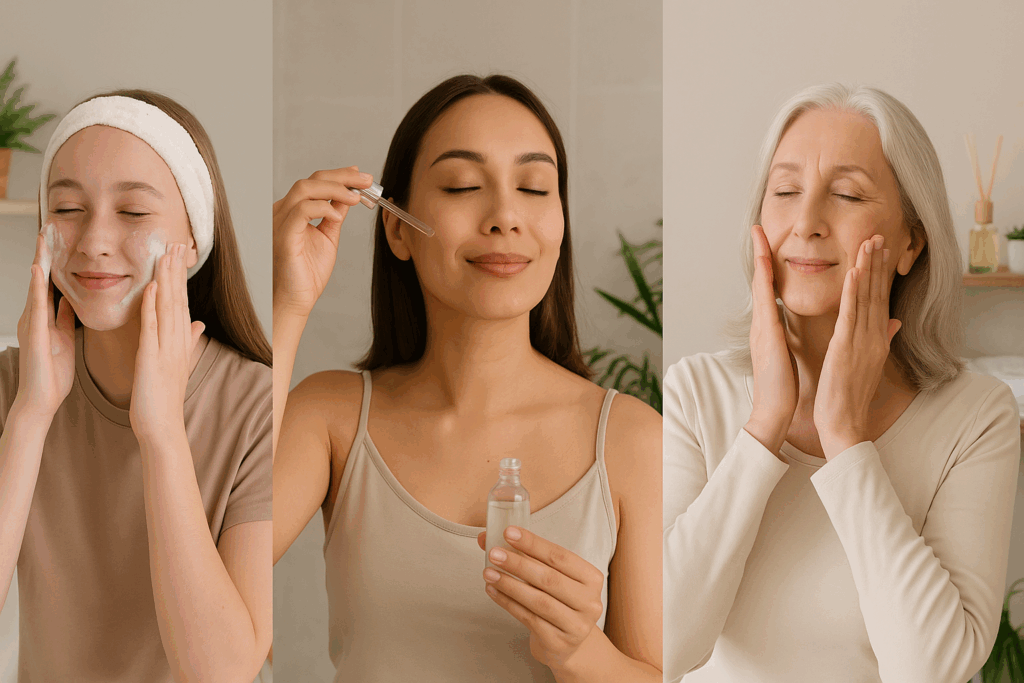
The 3 Step Face Care Ritual in Different Life Stages
As we move through various life stages, our skin evolves—and so should our skincare practices. One of the strengths of the three step skin care approach is its adaptability across the lifespan, offering continuity while allowing for meaningful customization.
In adolescence, when oil production ramps up and hormonal acne is common, a gentle yet effective 3 step face care routine can help young skin develop resilience. Focus on a mild cleanser with salicylic acid or tea tree, a serum that regulates oil and soothes inflammation (such as niacinamide or green tea extract), and a lightweight, non-comedogenic moisturizer. Educating teens early on about consistency, product integrity, and skin respect lays the foundation for lifelong skin health.
In the 20s and 30s, prevention becomes key. This is the time to focus on sun protection, antioxidant support, and hydration. Incorporate vitamin C serums, SPF moisturizers, and barrier-repairing ingredients like ceramides or panthenol. Sleep, stress management, and nutrition play crucial roles during these decades—what you do internally will show on your face externally. This is also a good time to refine your routine by eliminating unnecessary products and focusing on the essentials.
In midlife and beyond, skin may begin to show signs of slowed cell turnover, reduced elasticity, and increased dryness. The 3 step skin care routine still applies, but with richer formulations, regenerative actives like peptides or bakuchiol, and deeper hydration. Facial massage, gua sha, or warm compresses can help stimulate circulation and support lymphatic drainage. Emotional wellness becomes even more important here—skincare as ritual can become a sanctuary, a time of reflection and self-honoring in a busy life.
This adaptability is part of what makes the 3 step skincare routine so enduring. It honors change, celebrates simplicity, and provides the structure needed to evolve gracefully through every phase of life.
Frequently Asked Questions: The Holistic Approach to 3 Step Face Care
How can a 3 step face care routine support hormonal skin changes during menstruation or menopause?
Hormonal fluctuations during menstruation or menopause can cause sudden shifts in oil production, sensitivity, and hydration levels. A consistent 3 step face care routine can help buffer these effects by reinforcing the skin’s barrier and reducing inflammatory responses triggered by hormonal imbalances. During premenstrual phases, incorporating lightweight, balancing serums with niacinamide or willow bark in the second step can help preempt breakouts. For menopausal skin, step three may call for richer emollients that counteract estrogen-related dryness. Customizing the three step skin care framework based on hormonal cycles allows for stability in a time of internal transition, helping women respond to their skin’s needs with greater precision and empathy.
What role does the skin’s circadian rhythm play in a 3 step skin care routine?
The skin operates on a circadian rhythm just like the rest of the body, with different functions peaking during different times of day. During the day, the skin focuses on defense—guarding against UV rays, pollution, and oxidative stress. At night, its priority shifts to repair and regeneration. Aligning your 3 step skincare routine with this rhythm boosts its effectiveness. In the morning, prioritize lightweight antioxidants and SPF as part of step three to support protection. At night, richer moisturizers and restorative actives during steps two and three promote deeper repair when the skin is most receptive. This synchronization not only enhances product efficacy but also aligns with the body’s innate biological intelligence.
Can a minimalist 3 step skin care routine still support advanced skin goals like anti-aging or hyperpigmentation?
Yes, a minimalist 3 step skin care routine can be surprisingly effective when strategically crafted. The key lies in using multifunctional ingredients during the second step—treatment. For instance, a serum that combines stabilized vitamin C, ferulic acid, and peptides can address both hyperpigmentation and fine lines without requiring multiple layers. Step one supports product absorption by keeping the skin clean and pH-balanced, while step three seals in active benefits and maintains a robust moisture barrier. Instead of layering ten products, targeting skin concerns with one or two high-potency formulas within the 3 step face care structure often reduces irritation and boosts long-term results through consistency and barrier preservation.
How can men benefit from adopting a 3 step face care ritual?
While skincare marketing has traditionally targeted women, the principles of a 3 step skin care routine are universally beneficial. Men’s skin typically has larger pores and higher oil production due to testosterone, making a simplified, structured regimen especially effective in balancing sebum levels and preventing congestion. Cleansing (step one) removes buildup from shaving and sweat, while step two can incorporate soothing or hydrating serums that reduce razor burn or environmental stress. Moisturizers that are lightweight and fragrance-free in step three help maintain comfort and barrier health. A three step skin care ritual also introduces mindfulness into a daily routine, encouraging men to care for their skin as a vital aspect of self-maintenance rather than a cosmetic chore.
What’s the best way to transition from a complicated regimen to a 3 step skincare routine without causing disruption?
Transitioning to a simpler regimen should be done gradually to avoid shocking the skin, especially if you’re stepping down from active-heavy routines. Start by identifying one or two products in your current lineup that align with the 3 step skin care model, and slowly phase out anything redundant or overly harsh. Give your skin two to three weeks to adjust to the simplified approach, paying attention to any signs of barrier improvement or inflammation reduction. Focus on multifunctional ingredients that offer multiple benefits without layering. This approach allows the skin to recalibrate and often leads to better long-term outcomes due to reduced irritation and improved product compatibility within the 3 step face care structure.
How does climate affect which products to choose in a 3 step face care routine?
Climate plays a significant role in how products perform and what your skin needs. In humid environments, you might gravitate toward gel-based cleansers and lightweight hydrators that allow the skin to breathe. In contrast, cold or arid climates call for richer creams and more occlusive moisturizers in step three to prevent transepidermal water loss. During transitional seasons like spring or fall, it’s important to reassess and adjust the balance of your 3 step skincare routine—perhaps switching serums or cleansers while maintaining the same overall structure. Adapting your three step skin care to seasonal changes ensures it remains effective and in tune with your skin’s shifting needs throughout the year.
What are some emerging ingredients that complement a holistic 3 step face care approach?
Several emerging ingredients are gaining attention for their ability to support holistic skin health within a 3 step skincare routine. Postbiotics, for example, help strengthen the skin’s microbiome and can be added to step two serums for enhanced resilience. Adaptogenic botanicals like rhodiola or schisandra improve the skin’s stress response and may appear in step three moisturizers designed to protect against environmental stressors. Squalane derived from sugarcane is a sustainable emollient ideal for sealing in moisture without clogging pores. Copper peptides are another multifunctional option that aids collagen repair while reducing inflammation. These innovations expand the possibilities of a minimalist regimen, offering targeted results that align with the holistic philosophy of 3 step skin care.
Why is emotional consistency important in sustaining a 3 step skincare routine long term?
Skincare routines are easier to maintain when they’re emotionally satisfying, not just functionally effective. The repetitive, ritualistic nature of a 3 step face care routine can serve as a form of daily emotional regulation—providing moments of calm and control in a busy life. When this routine is infused with intention and mindfulness, it becomes more than maintenance; it becomes a grounding ritual. Emotional satisfaction reinforces consistency, which in turn leads to better outcomes and deeper self-trust. This connection between emotion and behavior makes the three step skin care model not just sustainable, but also transformative—supporting long-term wellness both inside and out.
How can a 3 step skin care routine be adapted for frequent travelers?
Frequent travelers benefit greatly from the portability and efficiency of a 3 step skincare routine. Travel exposes the skin to dehydrating environments—airplane cabins, hotel air conditioning, and shifting climates—all of which stress the skin’s barrier. A compact three step skin care set allows travelers to maintain consistency without compromising luggage space or skipping essential care. For cleansing, micellar water or balm cleansers that don’t require rinsing can be practical. Hydrating mists and barrier-repair serums offer step two treatment on-the-go, while travel-sized moisturizers with antioxidants protect against urban pollution and UV exposure. By sticking to a familiar 3 step face care framework, travelers can protect their skin and reduce disruption even in unpredictable conditions.
How do you know when to modify or upgrade your 3 step face care routine?
Signs that your 3 step face care routine may need an upgrade include persistent dryness, breakouts, uneven texture, or dullness despite regular care. Skin changes with age, lifestyle, and environment, so revisiting your product selection every six months can keep your routine relevant. If you’ve recently changed diet, medications, or moved to a different climate, these factors can also warrant updates. Sometimes, modifying just one product—such as swapping a lightweight moisturizer for a richer one—can make a noticeable difference. Regularly tuning into your skin’s cues, while keeping the 3 step skincare routine intact as your foundation, helps maintain harmony between simplicity and evolving needs.
Closing Thoughts: Embracing Skin Renewal from the Inside Out
In a world inundated with fast fixes and fleeting beauty trends, the essential 3 step face care ritual offers a return to something timeless—simplicity, presence, and deep nourishment. This is not just about skin; it’s about rhythm, ritual, and reclaiming the body as a sacred ally in wellness.
By focusing on three foundational steps—cleansing, nourishing, and moisturizing—we provide the skin with everything it needs to renew itself naturally. We reduce inflammation, enhance barrier function, and support the skin’s natural repair mechanisms. But we also do something more: we send a message to ourselves that we are worth showing up for, each day, in intentional ways.
The three step skin care method is more than an external regimen; it is a daily ritual of return. To ourselves. To balance. To the rhythms that heal. By integrating this practice into our holistic body care routines, we align with a philosophy that values health over hype, presence over perfection, and process over product. We rediscover the beauty of less—and in doing so, unlock the radiance that was always within.
So whether you’re just beginning your skincare journey or seeking a simpler, more grounded path, the 3 step face care ritual invites you to slow down, tune in, and glow from within. Because true skin renewal doesn’t begin with a product. It begins with presence.
Further Reading:
3 Steps or 10? The Truth Behind Skincare Routines